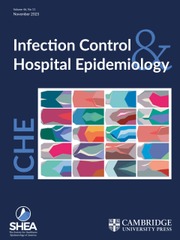No CrossRef data available.
Article contents
Utility of post-admission SARS-CoV-2 serial testing in hospitalized patients with cancer
Published online by Cambridge University Press: 03 December 2024
Abstract
SARS-CoV-2 asymptomatic surveillance testing (AST) is a common strategy to minimize the risk of nosocomial infection in patients and healthcare personnel. In contrast to admission screening, post-admission AST was less widely adopted.
This study describes the diagnostic yield of post-admission serial SARS-COV-2 testing in hospitalized patients at a large cancer center with mostly double-occupancy rooms.
Retrospective cohort study design. Post-admission SARS-CoV-2 tests were examined over a 18 month study period. Positive results were reviewed to determine true hospital-onset infections using a combination criteria of screening all sample cycle threshold (Ct) values >30, results of non-concordant repeat testing, and clinical symptoms.
Post-admission serial testing of 15,048 hospitalized patients during an 18-month study period at a tertiary care cancer center detected hospital-onset infection in 1.6% (n = 245 patients). Among all hospital-onset positive SARS-CoV-2 RNA tests, 13% were clinically false positive. Most true infections were mild to moderate in severity.
In summary, post-admission serial testing in a high-risk setting is a low-yield strategy with several unfavorable effects and should no longer be routinely applied.
- Type
- Original Article
- Information
- Copyright
- © Memorial Sloan Kettering Cancer Center, 2024. Published by Cambridge University Press on behalf of The Society for Healthcare Epidemiology of America



